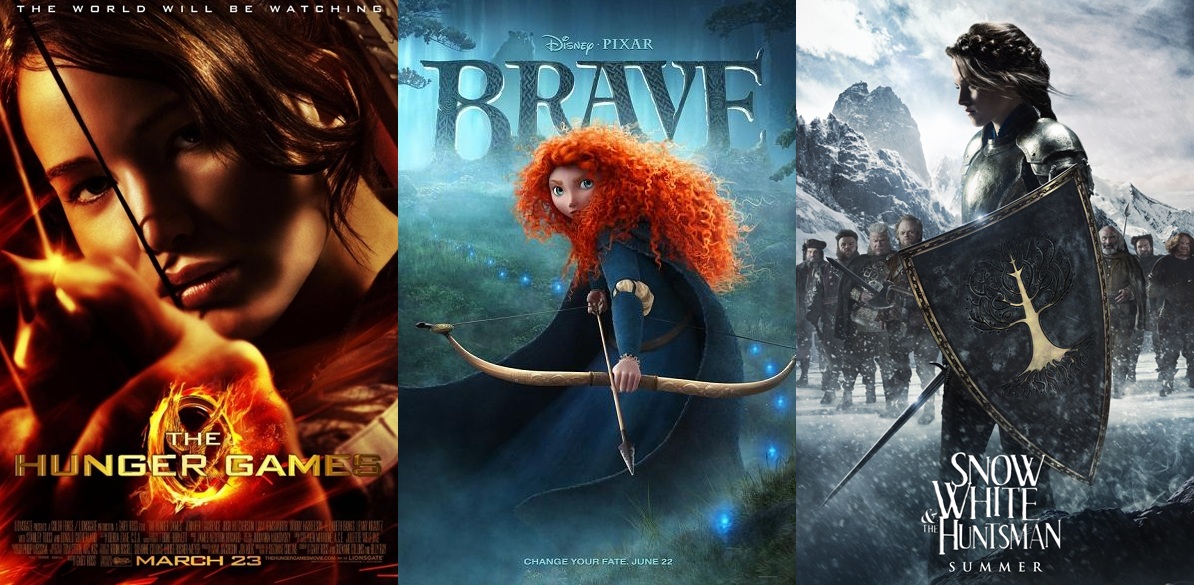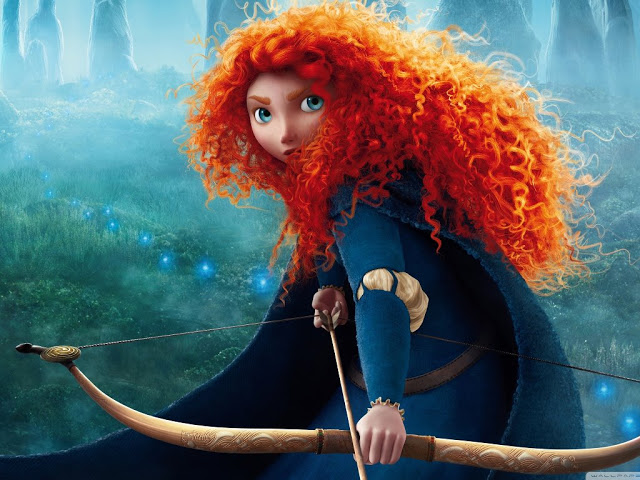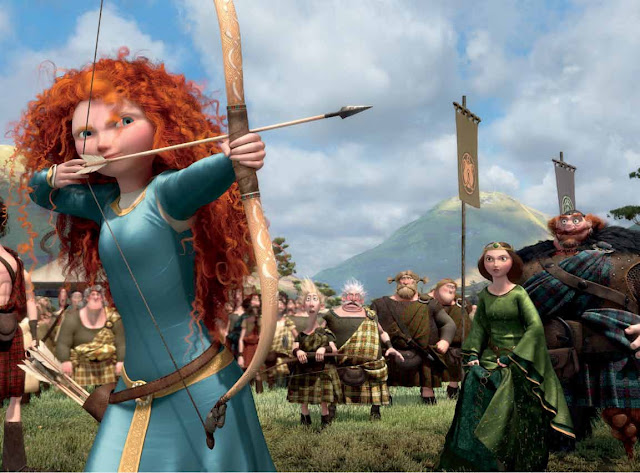Guest post written by Laura A. Shamas. Originally published at Women and Hollywood, cross-posted with permission.
Tag: Princess Movies
Will ‘Brave’s Warrior Princess Merida Usher In a New Kind of Role Model for Girls?
 |
| Brave‘s Merida (Kelly MacDonald) via Disney Pixar |
Originally published at Fem2pt0.
Merida (Kelly MacDonald) is a feisty Scottish highland princess. Her mother, Queen Elinor (Emma Thompson – is there nothing she can’t do??), wants her to be poised, articulate, and reserved – a proper princess. Merida wants none of that. A fierce archer, echoing Hunger Games’ Katniss Everdeen, she would rather ride horseback and explore. Her mother wants her to obey the rules and follow tradition. Merida wants the freedom to create her own destiny.
When we see a female lead, they’re usually the only girl or woman, surrounded by dudes as friends or love interests. We rarely see women working together in films, particularly children’s films. Yes, Queen Elinor wants Merida to get betrothed in an arranged marriage. But Merida defiantly rebels against this tradition. There’s no love interest. No romance. No winning the affection of a man. Instead, Merida competes for her own hand in marriage.
Passing the Bechdel Test, Brave captures the loving yet sometimes contentious relationship between mothers and daughters. Director Brenda Chapman was inspired to create the story by her own relationship with her daughter. Often in children’s films, the mother is absent or dead. As if the daughter just sprang from her father the way Athena emerged from Zeus. Now I’m all for single parents. I was raised by a single mom. But it’s disturbing we don’t see mothers. Queen Elinor was never villainized. Both Merida and her mother just want to be heard.
 |
| Merida (Kelly MacDonald) and her mother Queen Elinor (Emma Thompson) |
Something else unusual — something that shouldn’t be strange – you see Merida eat apples. Now, women and girls obviously eat. But you don’t normally witness female characters eating. Due to the media’s policing of female bodies, women and girls have an antagonistic relationship to food. Granted, Merida is still thin. But at least she’s athletic…and eating.
Chapman said she “wanted to give girls something to look at and not feel inadequate.” We’re told as girls and women we’re not pretty enough. We must lose weight or gain weight. We constantly have to control our bodies and ultimately ourselves.
Hair showcases the women’s identities. Merida’s unruly but gorgeous crimson hair symbolizes her rebellious spirit. When her mother dresses her to meet her suitors, she shoves Merida’s hair under a cap. While Merida struggles to loosen at least one curl. Merida doesn’t want to be groomed, perfect or pretty. She wants to be free like her curls. Merida also rips the seams of her confining dress in order to shoot her bow, symbolically breaking free from constrictions and defying tradition. Originally, Queen Elinor’s hair was groomed in thick braids. By the end of the film, her hair flows free and she’s riding a horse with Merida, symbolizing the loss of her rigidity.
Is Brave reducing women and girls to their physical appearances? No, I don’t think so. Instead, by utilizing visual cues (although sometimes the symbolism is a little too on the nose), I think Brave showcases the constraints of gender norms and patriarchy. And more importantly, how we need to break free. Being true to yourself, voicing your opinion and going after your dreams – these are the messages little girls (and boys) need to hear more often.
Is Brave perfect? No. It devolves into a lot of slapstick humor, not really my thing. But the legions of kids attending the 10pm Saturday night showing (really? Isn’t it past their bedtime?) emitted fits of giggles. I also wasn’t thrilled with the gender stereotypes. I appreciated King Fergus (Billy Connolly) and Queen Elinor’s marriage dodged chauvinism and was fairly egalitarian. But men fight and behave buffoonish while women are supposed to be reserved and docile. Both were leaders – the King in battle, the Queen respected in negotiations – but in their gendered spheres. But perhaps that’s the point. It conveys the tradition of patriarchy and how we need to shatter these gender tropes.
But my biggest problem? Brave is still a fairy tale and Merida is still a princess. Are we ever going to get away from princesses? Ever??
Why must we still package female characters for girls in this princess box? Princess culture has saturated – no, make that dominated – our society. Little girls are obsessed with princesses, tiaras, girlie-girl hues of pink and ball gowns.
In her fantastic book Cinderella Ate My Daughter, Peggy Orenstein dissects princess culture and its insidious message of hyperfemininity, sexualization of girls, rescue fantasies and obsession with finding Prince Charming. While princesses don’t necessarily lead to passive girls, they cause girls to feel – not that they can have it all – but that they must be everything to everyone. It’s this pressure of perfection which weakens their self-esteem.
There’s nothing inherently wrong with little girls wanting to look pretty and wear fun clothes. And of course everyone wants to feel special. But it’s problematic princesses are the only role models little girls see in media. Princess culture ultimately objectifies girls, telling them their self-worth lies in their beauty and ability to snag a man.
It’s a huge problem Pixar’s first female protagonist must still be a princess. Don’t get me wrong. Merida is a badass warrior princess who’s defiant, caring, brave and smart. And that’s awesome. But we need to eventually diverge from this princess paradigm and showcase more diversity in female characters.
With the rise of the warrior princess, a fusion of two female archetypes, I hope Brave bridges the old princess movies with a new narrative for girls. Thankfully, Merida herself challenges the princess label and notion of perfection. She’s outspoken, independent and opinionated. We see Merida make mistakes and figure out solutions herself. While she gets help, no one rescues her. Merida doesn’t want to be told how to look, who to marry, or how to behave. She wants to make her own choices. But I worry Hollywood will simply reinforce and perpetuate the princess paradigm, leading to female protagonists who appear empowered but aren’t really.
Brave is absolutely wonderful. Touching and sweet, it brought me to tears, my personal barometer for a great film. And it’s a huge step in the right direction.
A film that reads as a condemnation of patriarchy, I hope Merida leads to different kind of heroine; a truly empowered one. We need to see intelligent and emotionally strong female characters. Who possess career goals and go after their dreams. Who aren’t objectified and whose lives don’t revolve around finding a man.
Guest Writer Wednesday: Happily Never After: The Sad (and Sexist?) Rush to Cast Some of Our Most Promising Young Actresses as Fairy Tale Princesses
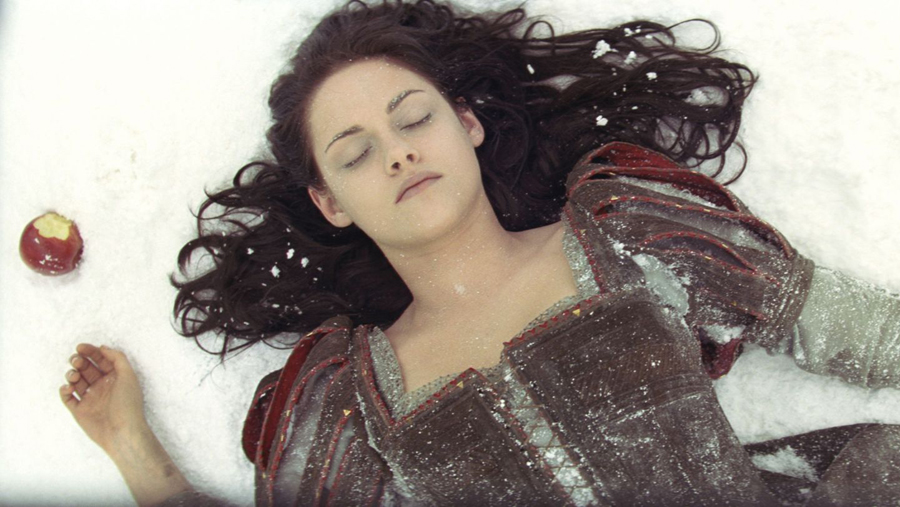 |
| Kristen Stewart as Snow White in Snow White and the Huntsman |
This guest post written by Scott Mendelson was originally published July 2011 at Mendelson’s Memos. Cross-posted with permission.
There were a few interesting articles written over the last several months about the unusual amount of ass-kicking (or at least take-charge) young female roles being written into mainstream cinema. Whether it was Chloe Moretz in Kick-Ass, Hailee Steinfeld in True Grit, Jennifer Lawrence in Winter’s Bone, or Saoirse Ronan in Hanna, the last 18 months or so has seen a mini-wave of genre pictures where young females were basically the lead characters (or in the case of Kick-Ass the star attraction), ‘strong independent character’ (god, I hate that cliche) who not only could fend for themselves but were not defined in any way, shape, or form by their male love interest (not a one of them had a boyfriend). Yes, I would include Sucker Punch in this category, as it was basically a satiric examination of whether ass-kicking young women in pop culture were automatically sexualized by virtue of the salacious nature of such imagery (stop whining and read THIS). The somewhat negative undercurrent of this trend is that these actresses were generally under 18, often barely passed puberty. Point being, what would become of these actresses once they reached adulthood? If recent developments are any indication, Hollywood has a genuine desire to roll back the progress clock and turn these actresses into fairy tale princesses.
At the moment, we now have two competing variations on Snow White set to be released in the next year. One, pictured below, will star Lily Collins (from The Blind Side and soon to be seen as Taylor Lautner’s token girlfriend in Abduction) as the titular princess, while the other will star Kristen Stewart as the ‘fairest of them all’. Both are claiming to be somewhat revisionist, and for the moment I shall take them at their word. But no matter how much armor and battle-axes you give Snow White, you’re still hiring one of our more talented actresses (say what you will about Twilight, but she absolutely sells Bella Swann and shines in the likes of Adventureland) to play a woman whose primary job is to run away from an evil witch, play house with a bunch of asexual dwarves, then finally bite a poison apple and await rescue from a theoretical Prince Charming. Of course, you could argue that Ms. Collins isn’t one of the ‘great actresses of our time’ yet. But the fact that we have two competing projects based on Snow White is a sad commentary on our times, both as a statement about how obsessed the studios are with any kind of brand recognition as well as the kind of roles available for actresses on the cusp of adulthood.
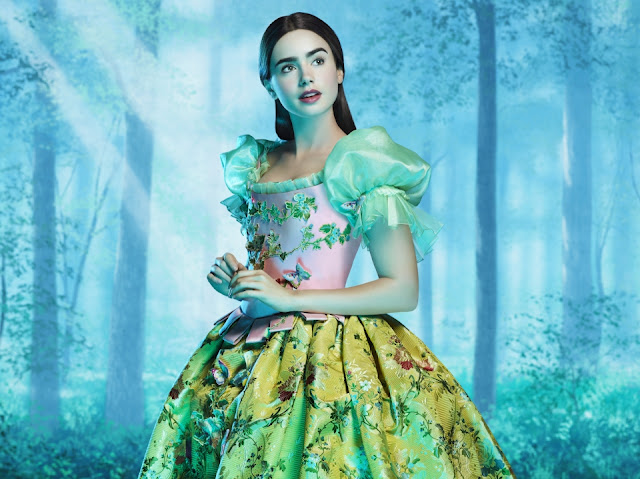 |
| Lily Collins as Snow White in Mirror, Mirror |
And it gets worse. What was Hailee Steinfeld’s reward for earning an Oscar nomination for Best Supporting Actress for a film where she was unquestionably the lead? What was her follow-up project for stealing True Grit from Jeff Bridges, Matt Damon, and Josh Brolin? She gets to play Sleeping Beauty in (yet again) a revisionist variation on that old-chestnut. And we’ll see who gets to play Princess Aurora in the other competing project, Maleficent (allegedly starring Angelina Jolie as the villain) which was to be directed by Tim Burton before he came to his senses. Worst of all (and the catalyst for this rant) is the news that Emma Watson, who portrayed one of the great feminist icons of recent times, Ms. Hermione Granger herself, is being wooed for the lead role in Guillermo del Toro’s live-action variation of yes, Beauty and the Beast. Never mind that Guillermo del Toro certainly has better things to do with his time. Never mind that we have no real need for a live-action version of “Stockholm Syndrome: The Movie” (even my 3 year old dismissed the Disney version, because she stated that the Beast was mean and a grouch). It is sadly predictable that, as soon as Ms. Watson (a fiery feminist in her own right) was able to basically play adult roles, she would be shoved into the helpless fairy-tale heroine box.
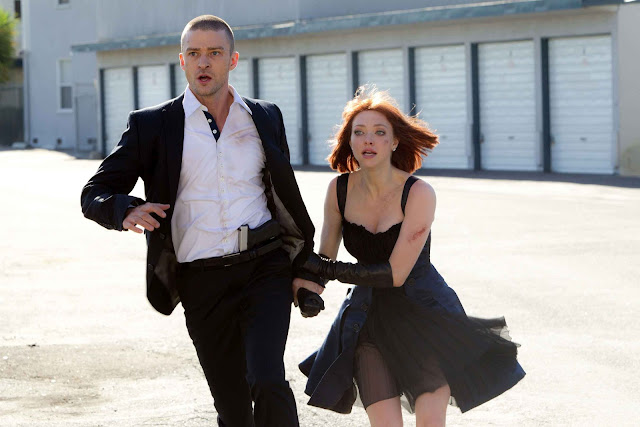 |
| Justin Timberlake and Amanda Seyfried in In Time |
And that is really the point. To be fair, it’s not an all-encompassing issue. Chloe Moretz remains fairy tale-free at this point, and Saoirse Ronan has yet to be cast in a theoretical live-action version of The Little Mermaid. She does have a ‘teen girls as hit-women’ caper with Alexis Bledel, Violet and Daisy, that I desperately want to see. And Dakota Fanning has yet to be cast as the token hot girl quite yet. But there remains a disturbing trend that allows young actresses to be vibrant and active in their onscreen fates only until they reach young adulthood. Once they are old enough to be legally sexualized, their worth as empowered heroines is seemingly lost and they end up being tasked with playing the token love interest (SEE Emily Blunt be pulled by the hand by Matt Damon in The Adjustment Bureau!), helpless hostage/potential woman in refrigerator (SEE Blake Lively as the kidnapped girlfriend of both Taylor Kitsch and Aaron Johnson in Oliver Stone’s Savages!), or both (SEE Amanda Seyfried as Justin Timberlake’s hostage who learns to love him in In Time!). It is as if female roles can only be worthwhile when they are too young to be viewed exclusively as sexual objects. Now there is a new category for which to pigeon hole these actresses: perfectly pretty princess. Once they are old enough to be cast in stereotypical female roles, it’s straight to the ‘token’ box, with an occasional diversion in fairy tale theater. Is this new mini-fad simply another variation on tokenism, or a more insidious attempt to keep said young actresses virginal and pure?
It is telling that bloggers and pundits bemoaned Jennifer Lawrence passing on Savages and picking The Hunger Games instead. Maybe, no matter how prestigious an Oliver Stone film might be (because he writes SO well for female characters…), Lawrence chose to be a lead in her own action franchise rather than play a random hottie who is abducted as a pawn in a drug spat involving her dueling boyfriends (on the surface, it seems like a prestige variation on Double Dragon). And it is telling that no one seems to notice or care that a number of our most promising young actresses are being jammed into the ‘girl cage’ just at the age when they would be old enough to play quality adult female roles. Of course, roles such as that are few and far between. For the likes of Watson and Steinfeld, it appears once again that the choice is between no mainstream roles or regressive token roles or playing a live-action Disney princess. Oh well, I’m sure they can find an episodic television series when the time comes. When it comes to quality roles for adult women, for too many actresses, it is television instead of film that is the pathway to happily ever after.
Scott Mendelson is, by hobby, a freelance film critic/pundit who specializes in box office analysis. He blogs primarily at Mendelson’s Memos while syndicating at The Huffington Post and Valley Scene Magazine. He lives in Woodland Hills, CA with his wife and two young kids where he works in a field totally unrelated to his BA in Film Theory/Criticism from Wright State University.
Tangled: A Feminist Film Review
This guest review by Whitney Mollenhauer first appeared at Not Another Wave in December 2010.
- Rapunzel’s father (the king) cries on Rapunzel’s birthday as he remembers his kidnapped daughter. It seems like usually in these kind of movies, you see the mom crying and the dad consoling her; but here, it’s the other way around. Win! Men can express emotion, too!
- Rapunzel sews and bakes, but she also reads, does astronomy, and paints like no other.
- She is so awesome with her hair! She ties the male protagonist up, lets herself down from the tower, and climbs everywhere. Seriously, it’s very impressive. She can do just about anything with that hair–it’s not just for show.
- Rapunzel ends up with short hair! Okay, that’s just a little thing, but have you ever seen a Disney princess with a pixie cut before? Even Mulan had longer hair!
- So yeah, the mom is the bad guy because she’s vain/wants to be young forever, blah blah blah. But I don’t know how they could have had a male villain or some other way for the mom to be the villain without straying too far from the original. But at least she gets some jokes.
- The frying pan proves to be a superior weapon compared to the sword! This might be getting a little too psychoanalytic, but I saw the frying pan as symbolizing a kind of feminine/transgressive power, while the sword represents traditional masculine power. I just thought it was neat. You don’t have to be a swashbuckling dude to kick butt.
- Her story and her adventure starts not because the guy “whisks her away” or something; but rather, she plans and schemes: she catches him breaking into her tower, and strategically decides to use him to reach her goal of seeing the flying lanterns on her birthday.
- Spoiler alert: in the end, she’s not “saved” because of her compassion, but in spite of it–her compassion might actually have been her downfall. Unlike other movies/fairy tales where a woman’s only redeeming quality is self-sacrifice, this ending suggests that self-sacrifice isn’t always such a good thing–or at least that it’s not solely the domain of women. Men can be self-sacrificing too! (Didn’t want to reveal too much here. Go see the movie if you want to figure out what on earth I’m talking about.)
- I liked the ambivalent nature of how it shows her mom’s and her relationship when Rapunzel leaves the tower for the first time. She feels guilty, but MAN is she happy and excited and brave!
- She doesn’t get married at age 18!!!!
- In my opinion, the relationship was not even really a central feature of the story, but rather a sub-plot. The main plot was getting away from her mother, figuring out her actual identity, getting to the flying lanterns she wanted to see.
- I felt like it was good and feminist because it was a major improvement from how Disney usually is. Also, overt sexism did NOT distract me from what was otherwise a visually appealing, witty movie (as it usually does). And that is really saying something.
- Even the rich, hypermasculine stereotype is challenged–the male protagonist reveals his true name/identity, as an orphan, and she says she likes him better than the fictional (hypermasculine) character that he aspires to be like.
- In the end, I think it makes a good case for women’s “proper place” NOT being just in the home, but out in the world/public sphere! I’m not sure how you could get any other moral out of it. Even in Mulan, after she saves China, she ends up returning home, and (we suspect) marrying the army captain guy, instead of taking a job with the emperor. In Tangled, the movie’s premise is centered around the idea that it’s wrong and horrible to expect a woman to spend her whole life at home.
- When the male protagonist breaks into her tower, she kicks his butt; she stands up for herself in the bar; and she stands up to her mother in the end (about having been kidnapped).
- At the end of the movie, SHE dips HIM and kisses him. (I always hated it when guys would dip me. If I want to kiss you, I am going to kiss you, so just let me stay on my own two feet.)
- Body image stuff: Okay, so Disney’s not breaking down any boundaries here. Also, infantilization much? Rapunzel’s face is that of a two-year-old.
- So, I’m not very good at remembering specifics, but I DO remember not getting angry at seeing her needing rescuing again and again and again. It seemed like mostly she was able to save herself, and the guy didn’t save her a whole lot.
- In the bar, Rapunzel and the guy (Flynn) meet a whole bunch of rough guys. They sing a song about how everyone’s got a dream: the one tough guy says to Flynn, “Your dream stinks,” referring to his dream of getting rich. The other tough guys have dreams of becoming mimes, finding love, being a pianist, becoming a baker–and one made little tiny unicorns. Even tough guys have nuance and feminine qualities!
- Rapunzel’s animal companion is Pascal the chameleon. Pascal is super cute, and is possibly named after Blaise Pascal the mathematician (suggesting that Rapunzel is a math nerd like me, though that could just be me reading too much into it). Pascal can’t talk, and I felt like that was a good thing (feminist-wise), so he couldn’t show her up and become the hero (remember Mushu the dragon in Mulan?)
